The Chatham Arts Council is investing in artists through our Meet This Artist series, introducing you to 12 Chatham County artists each year in a big way.
The fine folks at Hobbs Architects in downtown Pittsboro are powering our Meet This Artist series this year. Architecture is art, and the Hobbs crew values art in our community.
Take a look. Meet your very inspiring neighbors. Meet This Artist.
For painter and former set designer Patricia Martin, life in the art world started as a collaboration with the theater world. After getting her start in set design, Patricia made a name for herself as a scenic artist, working on such high profile designs as backdrops for the 1996 Olympics in Atlanta. But fine art kept calling her, and eventually she found happiness as a painter. Read on to learn more about this talented artist!
Tell me about yourself.
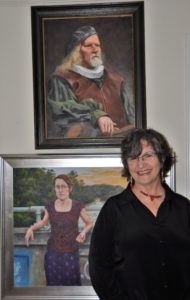
I grew up in Birmingham, Alabama. Our home was a very artistic environment; my mother has a wonderfully artistic eye and my father was a cartoonist. Art was always a big thing in my house. My mural career started when I was four. I remember very clearly being told not to draw on those freshly painted walls. My mother hates purple crayon to this day.
How did your art manifest itself in high school?
In high school, I created a lot of the backdrops for the prom pictures, and began designing sets for the theater department. My art teacher in high school was a portrait artist, and her parents were renowned artists; her mother did huge animal portraits. My drama teacher and my art teacher were partners, and together designed the sets for a lot of the shows at the Jewish Community Center (JCC) in Birmingham. That’s where I got started with set design. From then on, I was helping to design sets for the JCC and for high school productions. After high school, I went to college to study technical theater, but I ended up leaving college and just going to work instead.
I’ve been to college, but I don’t have a degree. I’m largely self taught. I probably have more credits than somebody with a master’s degree. I kept going back to school and taking classes. I kept trying to do other things besides art. I thought about going into criminal justice, and then architecture. But I kept leaving school to work as an artist instead.
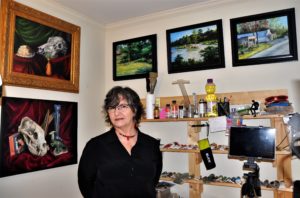
After I left school for the second time, I moved to Atlanta and started a design and production business. I got a quite a few contracts for the 1996 Olympics for set design, including the set for IBM for the International Olympic Committee. I also did murals and art for doctors’ offices and nursing homes. The one time I’ve ever gotten intimidated by a big piece was when I had four backdrops to do, and three of them were 60 feet and the other was a hundred feet. It was a sea of white on the floor, full of blank canvases that needed to be completed in a few weeks’ time. Thankfully, I had a crew of three or four people helping me.
Why did you close down your production business?
I got tired of schlepping scenery. Also, my business partner and I decided to go our separate ways so I was doing it all myself and it was getting to be too much for me. I started doing more murals in homes and things. I just wanted to be a fine artist. I wanted to bring things down. I wanted my work to have more depth and feeling.
What made you move to North Carolina?
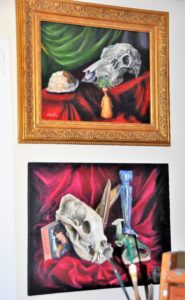
I moved here shortly after I got divorced. My best friend lives here, and I thought, “You know what? It’s time to get out of town.” I had been here to visit her before, and have always been drawn to this place.
In 2010, I stopped working as a commercial or commissioned artist. I thought I was done. I still worked on my craft for my own enjoyment and practice so that I could go back to being a professional, but I put the business part aside for a while. I got a desk job for the first time in my life. I was on the phone all the time.
But then a couple of years ago, I found out about the FACE Conference, which was in Williamsburg, VA that year. It’s a four-day convention of workshops, demonstrations, and lectures from the world’s leading artists, produced by Fine Art Connoisseur magazine. The artists do demos, and you watch them as they work. You can tell when they’re talking that they were chosen for being good teachers, as well as being good painters.
That conference changed everything for me. Talk about lighting a fire under you! It was a totally different energy. I learned about values, depths, and white light effects. Each brush stroke meant something.
Do you like living in Bynum?
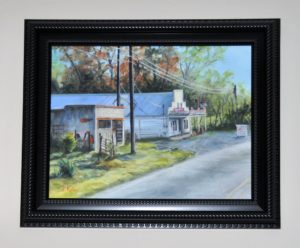
I’m very grateful to have landed here in Bynum. The energy I get from living on the river and near my friends absolutely feeds my soul. Bynum feels like a community that I’ve been missing for a long time; it feels like a place where I’m meant to be.
Before the pandemic, I would get together with some local artist friends every Monday. We would each bring in whatever project we were working on and just sit around the table and work on our projects and talk. It was great. When the pandemic hit, it became a Zoom call on Monday nights. The pandemic has given me the time and opportunity for quietude to allow me to focus on my work.
Tell me about the series of paintings of your neighbors in Bynum. Let’s start with “Love Sux.”
I asked Jessamine to pose for me, so one day we went down to the Bynum bridge at the end of the day, when there was gorgeous light. I was just taking pictures and talking to her. This pose just grabbed me, and the graffiti is just awesome. I have no idea what she was thinking right then. It’s such a pensive moment.
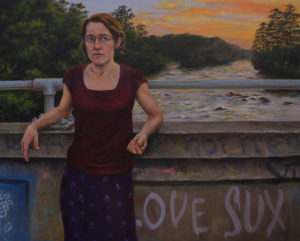
I’m fascinated with the couple in “Sh. Listen.”
This painting was born out of an idea that I had a long time ago. It was supposed to be a sociopolitical statement type of thing but I didn’t have the artistic chops to pull it off. I had a whole series planned, but that was the one that I thought was really cool. It was meant to show discourse among varying political beliefs. I originally thought it would be of a lawyer and a preacher, where one was smashing the other’s lips closed with a finger and the other one holding him so that they couldn’t talk. One of them would be holding a legal book and the other a Bible. It represented the beginning of all of this stuff that’s going on now. But by the time I got around to doing this, I just didn’t feel like that anymore. I wanted it to be more personal.
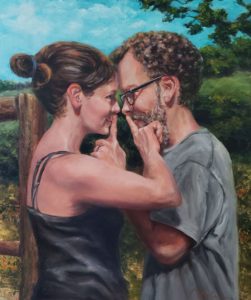
I started realizing that I’m kind of beyond that, so I thought I’d turn it into a relationship type of thing because they’re married. I just started taking pictures of them. I remember saying to them, “Y’all are married — act like you’re married!” Then they started playing around, which was where that pose came from. I think we need more play right now. I think we need beauty. People have enough strife and stress; we need more communication, and that is what this painting is about.
How about these two on the fence in “The Decision”?
They live in the neighborhood. When I used to be on the phone all the time for work, I would look out at that fence by the road. One day I was sitting here in the evening in the spring, and the light was just beautiful. When the sun went down, the weeds were totally backlit. It looked like they were on fire. Then those two kids came and sat down. The sun gave their hair the same treatment, so I snapped a picture of them with this painting in mind.
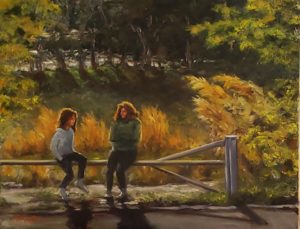
Tell me about the pet portraits.
I’ve always been an animal person, so I just kind of fell into it. I decided I wanted to do portraits. I love their personalities. I honestly feel like I get to know them a little bit when I paint their portrait. People feel very strongly about their pets; the emotion I see on their faces when they first see the portrait is extraordinarily rewarding.
What does the future look like for you?
I would like to be in a gallery. Most of my work right now is commissioned. But I also love doing landscapes. I love how humankind interacts with nature, for good or bad. That fascinates me as much as the portraiture does. It’s like the painting that I did called “Babysitting” of the deer in my yard. It’s called babysitting because the mother deer drops them off here in the afternoon for a couple of hours and then comes back and gets them. One of the fawns was born here, right in the peonies at the corner of my house. I was cutting the grass and all of a sudden I saw a little animal with wobbly legs. That’s why that painting means something to me. It’s the story behind it.

What would you tell a young artist who is torn between staying at their corporate art job and wanting to leave to make a go of it as a full-time fine artist?
Learn, learn, learn. Treat it as a business. You’re doing what you love, but it is still a business. Take it as seriously as you would any career; never stop learning your craft and schedule time to devote to marketing. If you want your art career to sustain you, people need to know about your work. Most of all, create what moves you. Authenticity is your greatest tool — never lose sight of that.
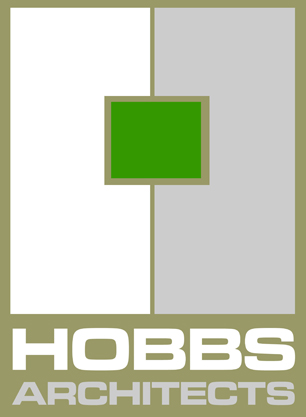
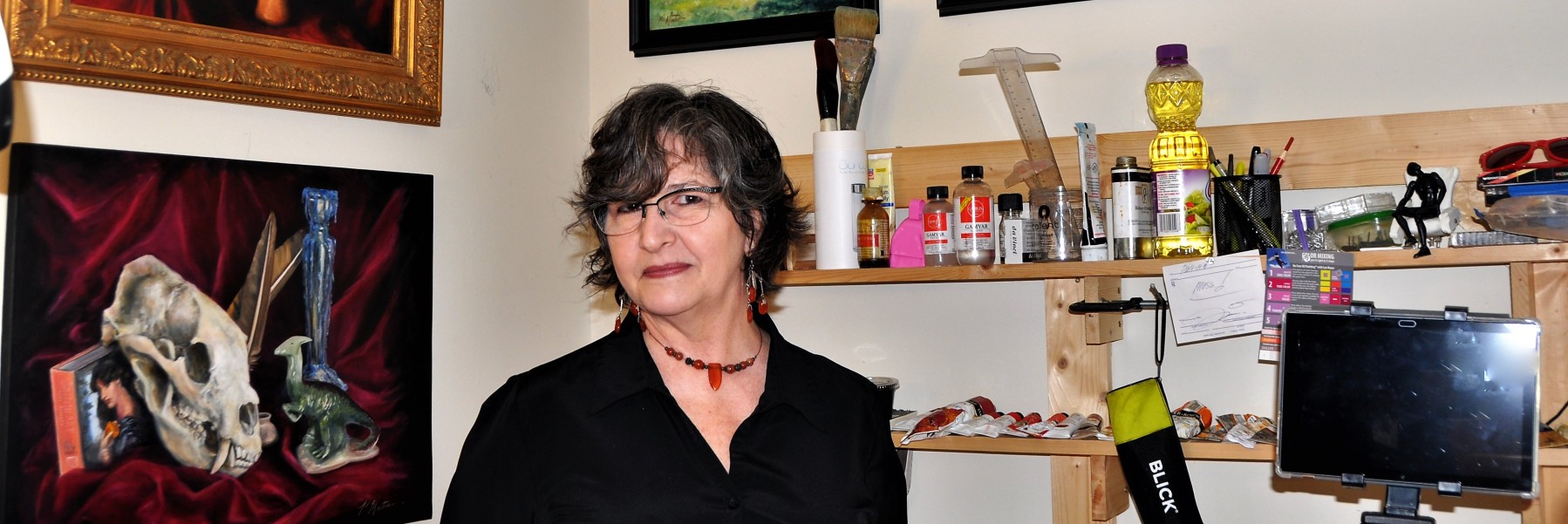
Leave a Reply